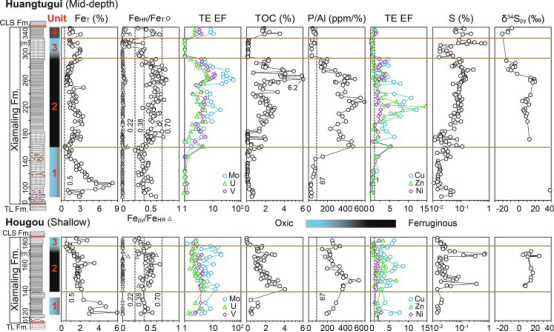“Spatiotemporal redox heterogeneity and transient marine shelf oxygenation in the Mesoproterozoic ocean” is published in Geochimica et Cosmochimica Acta (Volume 270, 1 February 2020, Pages 201-217). It is an achievement of Prof. LI Chao’s team from the State Key Laboratory of Biogeology and Environmental Geology. The first author is doctoral student WANG Haiyang, and LI is the corresponding author.
The Mesoproterozoic Era (1.6–1.0 Ga), long regarded as an interval of sluggish biotic evolution and persistently low atmospheric-oceanic oxygen levels, has become the subject of recent controversy regarding putative large-scale oxygenation events. In this study, we conducted a comprehensive investigation of redox, productivity, seawater sulfate concentrations, and hydrographic conditions for the∼1.4–1.32-Ga Xiamaling Formation in the shallow Hougou and mid-depth Huangtugui sections in the Yanshan Basin (North China). Integrated Fe-trace metal data suggest that bottom-water redox conditions mainly underwent a three-stage secular evolution: (1) suboxic (-oxic), (2) predominantly anoxic, and (3) oxic. Integrated productivity (TOC, P/Al, and Cu-Zn-Ni enrichment factors) and depositional system (major and trace elemental enrichment patterns) data suggest varying productivity levels during deposition of the Xiamaling Formation, with high productivity fueled mainly by intense open-marine upwelling. In combination with published data from the deep Xiahuayuan and Chicheng sections, a refined stratigraphic correlation framework was developed for the Xiamaling Formation based on the basinal upwelling event and existing lithostratigraphic framework. Within this new framework, sulfur concentration and pyrite δ34S (δ34Spy) data suggest a rise in marine sulfate concentrations at∼1.36 Ga. Furthermore, strong spatiotemporal redox heterogeneity was observed within the∼1.4–1.32-Ga Yanshan Basin, i.e., strong bottom-water anoxia (or euxinia) in deep sections and less anoxic (even oxic) conditions in shallow sections, although all sections experienced high productivity owing to oceanic upwelling. We propose a productivity-driven shelf oxygenation model to explain this spatiotemporal redox heterogeneity within the context of eustatic changes, an upwelling event, and the rise of oceanic sulfate concentrations at∼1.36 Ga. In this model, from initially low atmospheric oxygen levels, increasing surface productivity in shelf areas due to elevated nutrient supplies from upwelling not only intensified bottom-water anoxia through organic matter export but also stimulated expansion of the ocean-surface oxic layer through photosynthetic O2 release, contributing to the development of contrasting bottom-water redox conditions between shallow and deep sections during the upwelling event identified in this study. Our model helps reconcile conflicting observations concerning Mesoproterozoic marine redox conditions, and provides new insights into putative Mesoproterozoic oceanic oxygenation events and their relationship to the evolution of early eukaryotes.

Fig. 1. Locality, paleogeography and stratigraphy. (A) Global paleogeography at 1380 Ma (modified from Pisarevsky et al., 2014). Maw = Mawson Craton, La = Laurentia, SAC = South Australian Craton, WAC = West Australian Craton, NAC = North Australian Craton, Sib = Siberia, NC = North China, Ba = Baltica, SF = São Francisco, In = India. Note that the NC was rotated about 100° counter-anticlockwise relative to its modern orientation. (B) Location of the Yanshan Basin (red rectangle) in the North China Craton (NCC). (C) Paleogeography of the Yanshan Basin during deposition of the Xiamaling Formation (modified from Qiao and Wang, 2014). (D) Stratigraphic column of the Xiamaling Formation at Xiahuayuan (Wang et al., 2017), Chicheng (Diamond et al., 2018), Huangtugui and Hougou (this study) sections. Roman numerals (II-IV) refer to lithological members. Radiometric ages are from Zhang et al. (2015). The sea level curve next to Xiahuayuan section is from the nearby Zhaojiashan section (Fan, 2015). Purple solid/dotted lines represent stratigraphic correlations (see detail in the text). Fm = Formation; CLS = Changlongshan; TL = Tieling. (For interpretation of the references to colour in this figure legend, the reader is referred to the web version of this article.)

Fig. 2. Key geochemical profiles of the Xiamaling Formation for paleoredox and paleoproductivity reconstruction at Huangtugui and Hougou sections. Lithologic legend as in Fig. 1. Units 1–4 are defined based on redox variations (see text in Section 5.1). The vertical lines in Fe-ratio box represents key threshold values of Fe speciation proxies discussed in the text. The vertical dotted line at 87 in P/Al box represents average shale P/Al (Taylor and McLennan, 1985). Fm = Formation; CLS = Changlongshan; TL = Tieling.

Fig. 3. Discriminant diagrams for Xiamaling Formation. (A) TiO2 vs. Zr. All samples from both study sections are consistent with a predominantly felsic source (Hayashi et al., 1997). (B) Th/Co vs. La/Sc. All samples show relatively narrow and high La/Sc and Th/Co ratios, which is consistent with a felsic source (Cullers, 2002). (C) P/Al vs. FeHR/FeT. Higher P/Al values are mainly associated with FeHR/FeT > 0.38, representing anoxic bottom-water conditions (Poulton and Canfield, 2011). (D) P/Al vs. TOC. P/Al and TOC exhibit a positive relationship in the Hougou section (r = +0.65, p < 0.001) but no relationship in the Huangtugui section.
Full Text: https://www.sciencedirect.com/science/article/pii/S0016703719307367